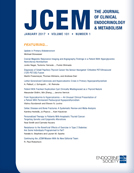-
Views
-
Cite
Cite
SCOTT E. MONROE, ROBERT B. JAFFE, A. REES MIDGLEY, Regulation of Human Gonadotropins. XII. Increase in Serum Gonadotropins in Response to Estradiol, The Journal of Clinical Endocrinology & Metabolism, Volume 34, Issue 2, 1 February 1972, Pages 342–347, https://doi.org/10.1210/jcem-34-2-342
Close - Share Icon Share
Abstract
Two potential but very different roles played by estradiol during the normal menstrual cycle were investigated: 1) the ability of estradiol to release pituitary luteinizing hormone; and 2) the possible role of estradiol as an inhibitor of follicular development. In the first study, five regularly cycling women were given estradiol benzoate (5 μg/kg) between days 2 and 6 of their menstrual cycle. Within 12 to 48 hours of the last estradiol injection, all subjects had a 2- to 4-fold elevation in serum LH concentrations but no significant rise in FSH concentration as compared to pretreatment levels. Eleven to fourteen days prior to menstruation there was a second surge of LH and a small FSH surge. Serum progesterone concentrations rose in four of the five subjects after the second but not the first LH surge. The elevation in serum LH concentrations following estradiol administration may have been a direct result of the increased estradiol concentrations or, alternatively, a consequence of the decline of this hormone from peak levels. In the second study, 3 women received daily doses of estradiol benzoate (5 to 10 μg/kg) on days 9 to 12 of their cycle. Within 48 hours of the last estradiol injection there was a significant LH surge and a small FSH surge followed by a second LH and FSH surge 7 to 13 days prior to menses. Ovulation, as suggested by increased serum progesterone concentrations, once again occurred after the second but not the first LH surge. The failure of ovulation to occur in each of these 3 subjects following a significant LH elevation suggests that estradiol, per se, may exert a direct inhibitory effect on follicular development or alter the follicle in such a manner as to make it refractory to a presumably ovulatory surge of LH.





